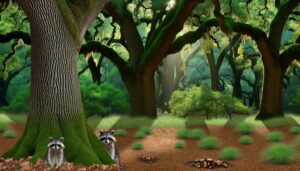Do Raccoons Like Light at Night?
Raccoons are nocturnal mammals with peak activity after dark, thriving due to their developed senses of vision, touch, and smell. While artificial light disrupts their natural circadian rhythms and may alter their behavior, the impact varies.
Light can make raccoons more visible to predators and potentially deter them from foraging in well-lit areas. However, some raccoons may adapt by exploiting illuminated environments for easier access to food.
The relationship between raccoons and light at night is multifaceted and influenced by various ecological and behavioral factors. To explore these intricacies further, consider additional information on their nocturnal habits and responses to artificial lighting.
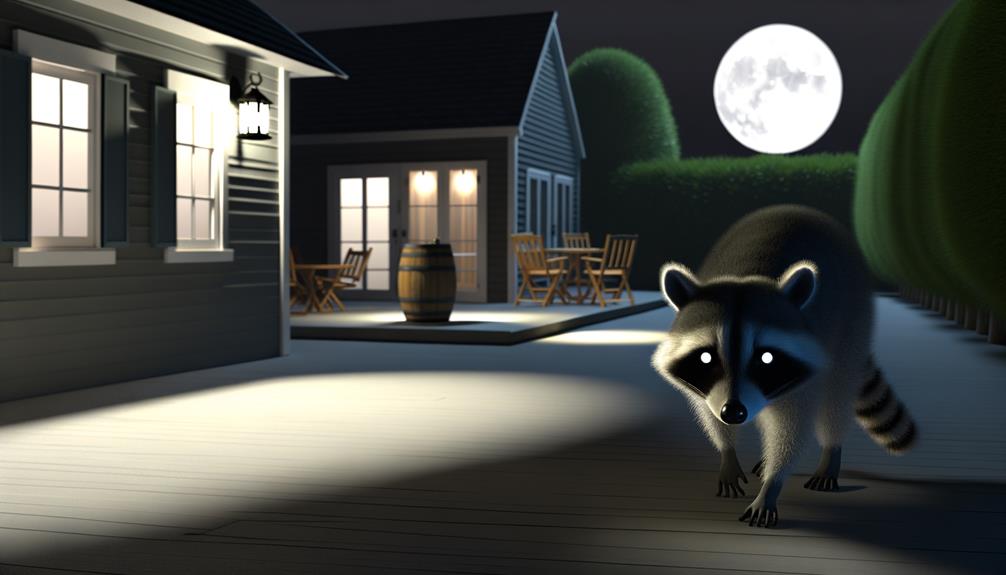
Key Takeaways
- Raccoons are nocturnal and generally avoid brightly lit areas to evade predators.
- Artificial light can disrupt raccoons' circadian rhythms and stress them.
- Raccoons may forage in illuminated areas due to better visibility of food.
- Homeowners report increased raccoon activity in well-lit environments.
- Raccoons might show aversion to high-intensity lighting, altering their behavior.
Raccoon Nocturnal Behavior
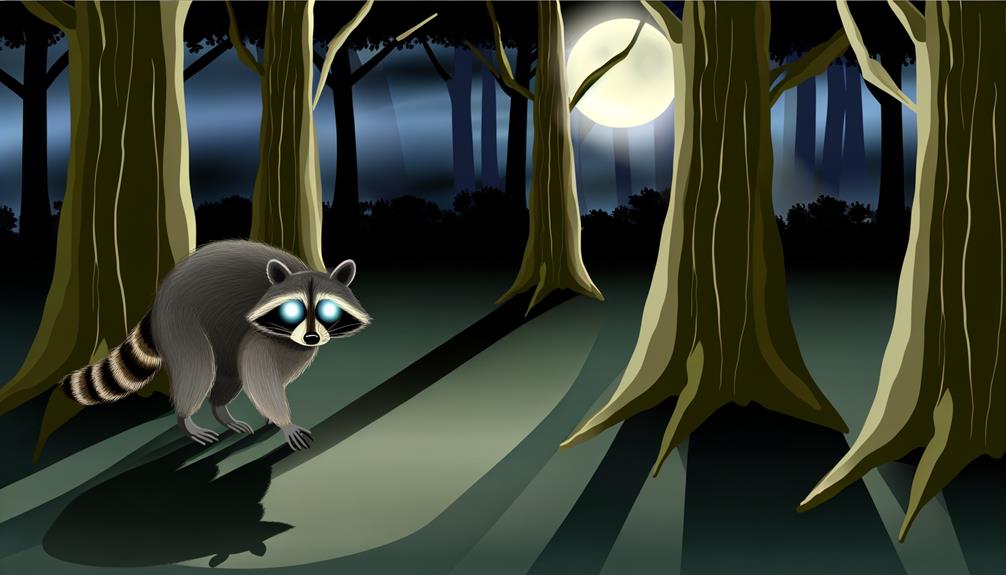
Raccoons are mainly nocturnal mammals, exhibiting peak activity during the night. This nocturnal behavior is primarily attributed to their evolutionary adaptations, which provide advantages in foraging and predator avoidance.
Their highly developed sense of vision and touch allows them to navigate and locate food efficiently in low-light conditions. Studies have shown that raccoons' retinas are rich in rod cells, enhancing their night vision. Additionally, their keen sense of smell aids in detecting food sources.
Nocturnality also reduces competition with diurnal species. This adaptive behavior ensures raccoons exploit available resources effectively while minimizing encounters with potential threats. Understanding these behavioral patterns is important for comprehending raccoon ecology and the implications of introducing artificial light into their natural habitats.
Attraction to Urban Areas
Urban environments offer a range of easily accessible food sources and shelter, making them highly attractive to nocturnal wildlife such as raccoons. Residential areas, commercial zones, and public parks provide diverse foraging opportunities, including garbage bins, pet food, and garden produce.
Moreover, the architectural structures present in urban settings, such as attics, basements, and sheds, offer raccoons ample nesting sites and protection from predators. The adaptability of raccoons to a variety of food sources and their dexterous front paws facilitate their ability to exploit human habitats efficiently.
Consequently, raccoons tend to thrive in urban areas, often leading to increased human-wildlife interactions. Understanding these behaviors is essential for developing effective management strategies to mitigate potential conflicts.
Impact of Artificial Light
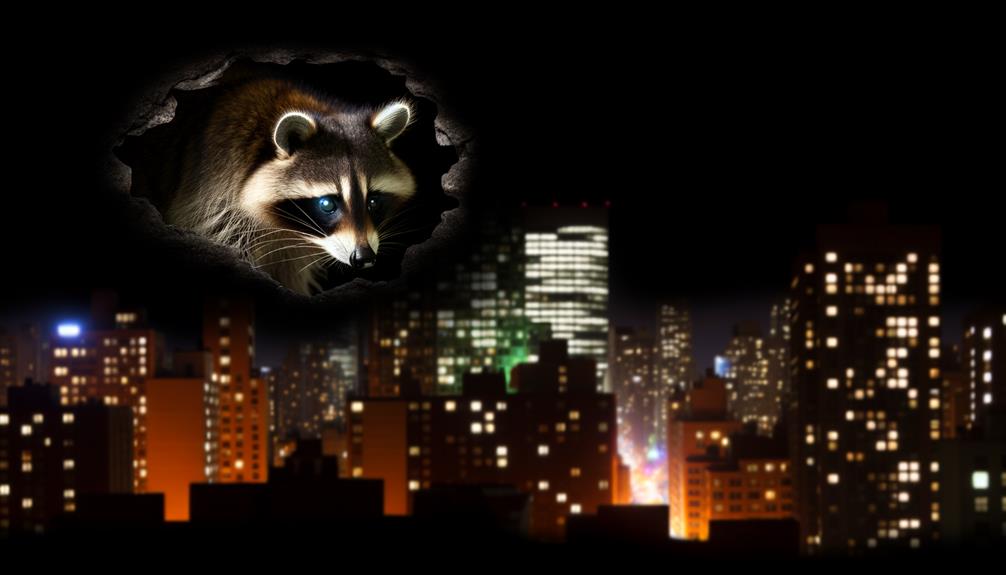
Artificial light at night can greatly influence the behavior and physiology of nocturnal wildlife. For raccoons, exposure to artificial lighting can disrupt natural circadian rhythms, leading to changes in activity patterns.
Studies indicate that raccoons tend to increase their nocturnal activity in illuminated environments, potentially due to the enhanced visibility and reduced risk of predation. Additionally, prolonged exposure to artificial light may affect raccoons' hormonal balances, particularly melatonin levels, which are vital for regulating sleep and other physiological processes.
The impact of artificial light is not solely limited to individual behavior; it can also influence broader ecological dynamics, including predator-prey interactions and competition among species. Understanding these effects is essential for developing strategies to mitigate light pollution's ecological consequences.
Light and Feeding Habits
Raccoons possess a distinct nocturnal vision advantage, allowing them to forage efficiently under low-light conditions.
However, the presence of artificial light can alter their feeding habits, potentially disrupting their natural foraging patterns.
Understanding how light influences these behaviors is essential for evaluating the broader ecological impact of urbanization on raccoon populations.
Nocturnal Vision Advantage
Adaptations in nocturnal vision provide raccoons with a significant advantage in low-light environments, impacting their feeding habits. These mammals possess a high density of rod cells in their retinas, which enhances their ability to detect minimal light.
Additionally, the presence of a reflective layer behind the retina, known as the tapetum lucidum, further amplifies available light, improving their night vision.
Key advantages of raccoon nocturnal vision include:
- Enhanced detection of prey: Improved ability to spot small animals and insects.
- Better navigation: Facilitates movement through complex terrains.
- Efficient foraging: Enables identification of edible plant materials and food scraps.
- Predator evasion: Increased capacity to detect and avoid potential threats.
These adaptations collectively support raccoons in their nocturnal feeding activities.
Light Impact on Foraging
The presence of light at night can greatly influence raccoons' foraging behavior by altering their natural patterns and affecting their ability to exploit food resources.
Raccoons are primarily nocturnal, relying on darkness to avoid predators and to utilize their acute night vision. Artificial light sources, such as streetlights and residential lighting, can disrupt these behaviors by creating an environment that is less conducive to their nocturnal activities.
Studies have shown that raccoons exposed to increased light levels may alter their foraging times, avoid well-lit areas, and experience changes in diet due to the availability of different food sources.
Consequently, the presence of light can reduce foraging efficiency and increase energy expenditure, impacting raccoons' overall fitness and survival.
Light and Social Interactions

The presence of artificial light at night can greatly influence raccoon social interactions, particularly their nighttime gathering behaviors.
Studies indicate that raccoons might alter their group dynamics and communication patterns in response to illuminated environments.
Understanding the impact of light on these social structures is essential for comprehending raccoon behavior in urban settings.
Nighttime Gathering Behavior
Raccoons exhibit complex nighttime gathering behaviors that are greatly influenced by the presence of artificial light sources. These behaviors, fundamental to their survival and social structures, can be observed in various urban and suburban settings. Artificial lighting can alter their natural activities, leading to notable shifts in their social interactions and foraging patterns.
Key observations include:
- Altered Foraging Patterns: Light can extend their active periods by simulating twilight, affecting food search efficiency.
- Communication: Increased visibility may enhance or hinder their vocal and non-vocal communication.
- Predator Avoidance: Light allows raccoons to better detect predators, but also makes them more visible to threats.
- Territorial Behavior: Artificial illumination can influence territorial boundaries and conflict frequency.
Understanding these impacts is essential for wildlife management and urban planning.
Light's Impact on Groups
Artificial lighting greatly influences raccoon social interactions by modifying group dynamics and altering communication patterns. Increased illumination can disrupt the natural behaviors raccoons exhibit in darkness, often leading to reduced social cohesion and altered mating rituals.
Studies indicate that raccoons exposed to artificial light at night exhibit decreased vocalization frequencies, which are essential for maintaining group structure and coordination. Additionally, increased light levels can lead to heightened stress responses, causing raccoons to become more solitary and less inclined to participate in group foraging activities.
This disruption in normal social behavior may have broader ecological implications, affecting population dynamics and predator-prey relationships. Understanding these impacts is essential for developing wildlife management strategies that mitigate the adverse effects of artificial lighting.
Light and Predation Risks
Exposure to light at night can greatly impact raccoons' susceptibility to predation. Increased illumination disrupts their natural activities, making them more visible to predators. This heightened visibility can significantly alter their foraging behavior and movement patterns, thereby increasing their predation risk.
Empirical studies suggest several pertinent effects of nighttime lighting on raccoons:
- Increased Visibility: Artificial light makes raccoons more noticeable to nocturnal predators.
- Behavioral Changes: Raccoons may alter their typical foraging routes to avoid lit areas.
- Stress Response: Exposure to light can induce stress, affecting their survival instincts.
- Predator-Prey Dynamics: Light pollution can shift the balance, favoring predators over raccoons.
Understanding these dynamics is important for wildlife management and conservation efforts aimed at mitigating the adverse effects of artificial night lighting.
Homeowner Observations
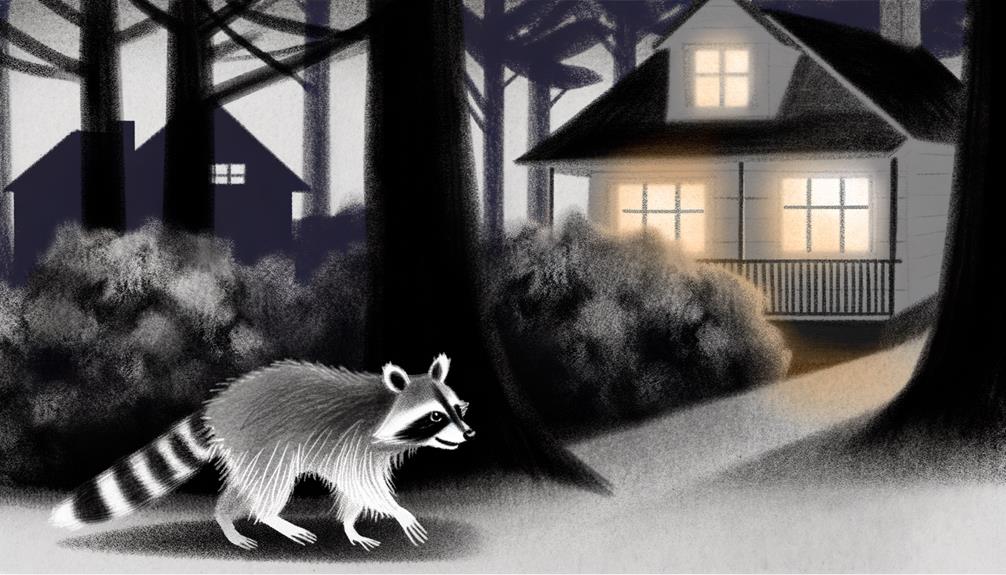
Homeowners often report observing changes in raccoon behavior corresponding to varying levels of artificial night lighting in residential areas. Anecdotal evidence suggests that raccoons may exhibit increased boldness and frequency of activity in well-lit environments. Reports indicate that raccoons often forage in illuminated areas, possibly due to the enhanced visibility of food sources and decreased predation risk.
Conversely, some homeowners note that raccoons avoid brightly lit spaces, suggesting a potential aversion to high-intensity lighting. These observations indicate a complex interaction between raccoons and artificial light, likely influenced by factors such as light intensity, food availability, and local predator presence.
Further empirical studies are needed to fully understand the behavioral adaptations of raccoons to artificial night lighting.
Wildlife Management Tips
To effectively manage raccoon activity in residential areas, it is essential to implement strategies that address their attraction to artificial night lighting. Raccoons are nocturnal animals that can be drawn to well-lit environments, which may increase their presence in these areas. By taking specific actions, homeowners can mitigate these occurrences.
- Install motion-activated lighting: This reduces constant light exposure, deterring raccoons while conserving energy.
- Secure trash and food sources: Properly store garbage and pet food to minimize attractants.
- Use raccoon repellents: Apply chemical or natural repellents around the property to discourage raccoon activity.
- Maintain landscaping: Trim trees and shrubs to eliminate potential nesting sites and reduce raccoon access to rooftops.
These measures can notably reduce raccoon intrusions in residential zones.
Future Research Directions

Future research directions should focus on understanding the specific behavioral responses of raccoons to varying intensities and durations of artificial light at night.
Investigations should include controlled experiments to isolate the effects of different light wavelengths and luminosities on raccoon activity patterns.
Additionally, long-term field studies are necessary to assess how habitual exposure to artificial light influences raccoon foraging behavior, reproductive success, and predator-prey interactions.
Employing advanced tracking technologies and behavioral analytics will enhance data accuracy and reliability.
Comparative studies involving other nocturnal species could provide broader ecological insights.
Such research is essential for developing effective wildlife management strategies that mitigate the impact of light pollution on raccoon populations and other nocturnal wildlife.
Conclusion
The nocturnal behavior of raccoons intersects intriguingly with their attraction to urban environments, where artificial light is prevalent. This coincidence impacts their feeding habits, social interactions, and predation risks.
Homeowner observations and wildlife management strategies must adapt to these behavioral nuances. Future research is essential to further elucidate these interactions, offering insights for more effective wildlife management and urban planning.
Consequently, the interplay between raccoon behavior and artificial light remains a critical area of ecological study.



